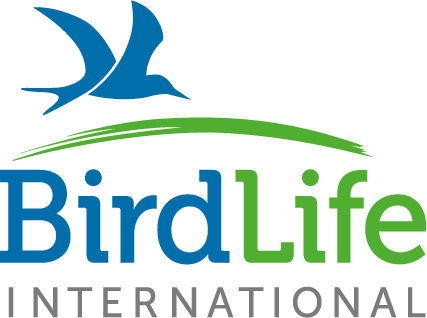1) Bispeenge and Munkemaen
2) Brændegårdsø & Nørresø
3) Bøjden Nor
4) Enebær Odde & Hofmansgave
5) Fyns Hoved
6) Føns Vang
7) Gulstav Mose & the southern point of Langeland
8) Gyldensteen Strand
9) Monnet
10) Tryggelev Nor
11) Vejlen
12) Ølund Lammesø nature reserve
Bispeengen and Munkemaen
A few kilometers from the centre of Odense
An oasis with a varied bird life in urban surroundings.
See Google map with carparks, observation points, etc.
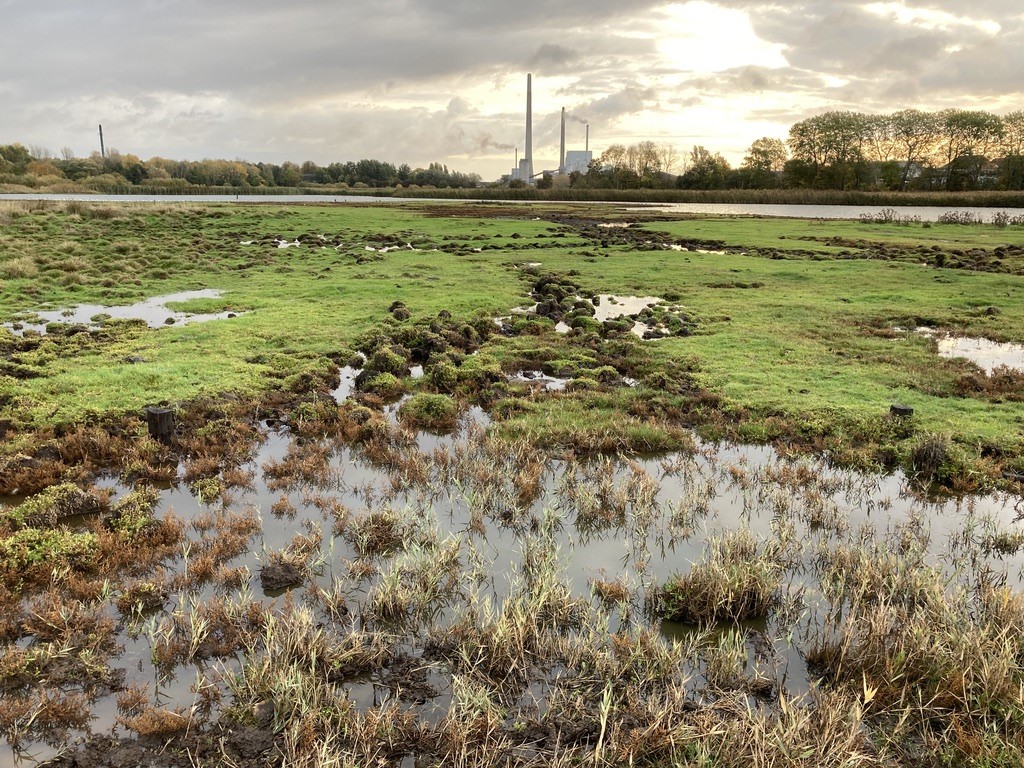
Bispeenge. Photo: Bent Juhler
Description:
The area originally formed the innermost section of Odense Fjord with wet meadows which were grazed for hundreds of years by cattle from the Odense monasteries. In the 1970s several roads were built over the area and some allotments were established on higher ground to the west. These initiatives resulted in a deterioration of the nature quality. However, the pumping system broke down in 2007, resulting in the formation of a shallow lake which attracted many birds, and the municipality of Odense decided to preserve the lake, wet meadows, ponds and reedbeds as a natural area.
It is now planned to create as natural a hydrology for the area as possible and to carry out grazing to prevent growth of more reeds and scrub. Many rare and threatened plants grow on the meadows.
Birds:
To date, more than 170 bird species have been observed in the area.
Breeding birds:
Greylag goose, shelduck and mallard breed at the lake and on the meadows. There are a few pairs of lapwing, together with redshank. Marsh harrier, water rail and bearded tit breed yearly in the reedbeds. Bispeenge was probably the first site on the island of Funen to house breeding bluethroat. Corncrake and grasshopper warbler are seen or heard now and again, but not regularly.
Migrating and staging birds:
Every year, little ringed plover, lapwing and snipe can be seen on migration, together with various tringa waders such as spotted redshank, redshank, greenshank, green sandpiper and common sandpiper. Many ducks turn up on migration or stage here during the winter months, for example wigeon, teal, garganey and shoveler. Migrating passerines include whinchat, wheatear and red-backed shrike. Kingfisher has been spotted on a few occasions.
Rock pipit is seen every winter. White-tailed eagle has often been observed.
Visiting and Access:
Ringroad 2 around Odense crosses the southern part of the area (where the road is called “Odins Bro”). By driving north at the crossroads Odins Bro/Otterupvej (route 162) you immediately reach a car park on the right-hand side of the road. From here, one can go north through the allotments to reach a bridle path that crosses the meadows in a south-easterly direction. From this path there is a good chance of spotting the birds in the reedbeds. Otherwise, one can continue through a little copse to reach a cycle path, which divides the area. From here there is a very good view over the wet areas, where most of the ducks and waders can be seen. From the car park it is also possible to walk along the cycle path under Otterupvej to a little lake, where there are breeding red-necked grebe. Alternatively, one can follow the cycle path which runs parallel to Odins Bro and leads to the embankment at the canal. The canal path runs along the top of the embankment and from here there is also a view over the area.
For further details and suggestions for alternative parking and lookout points, see the google map.
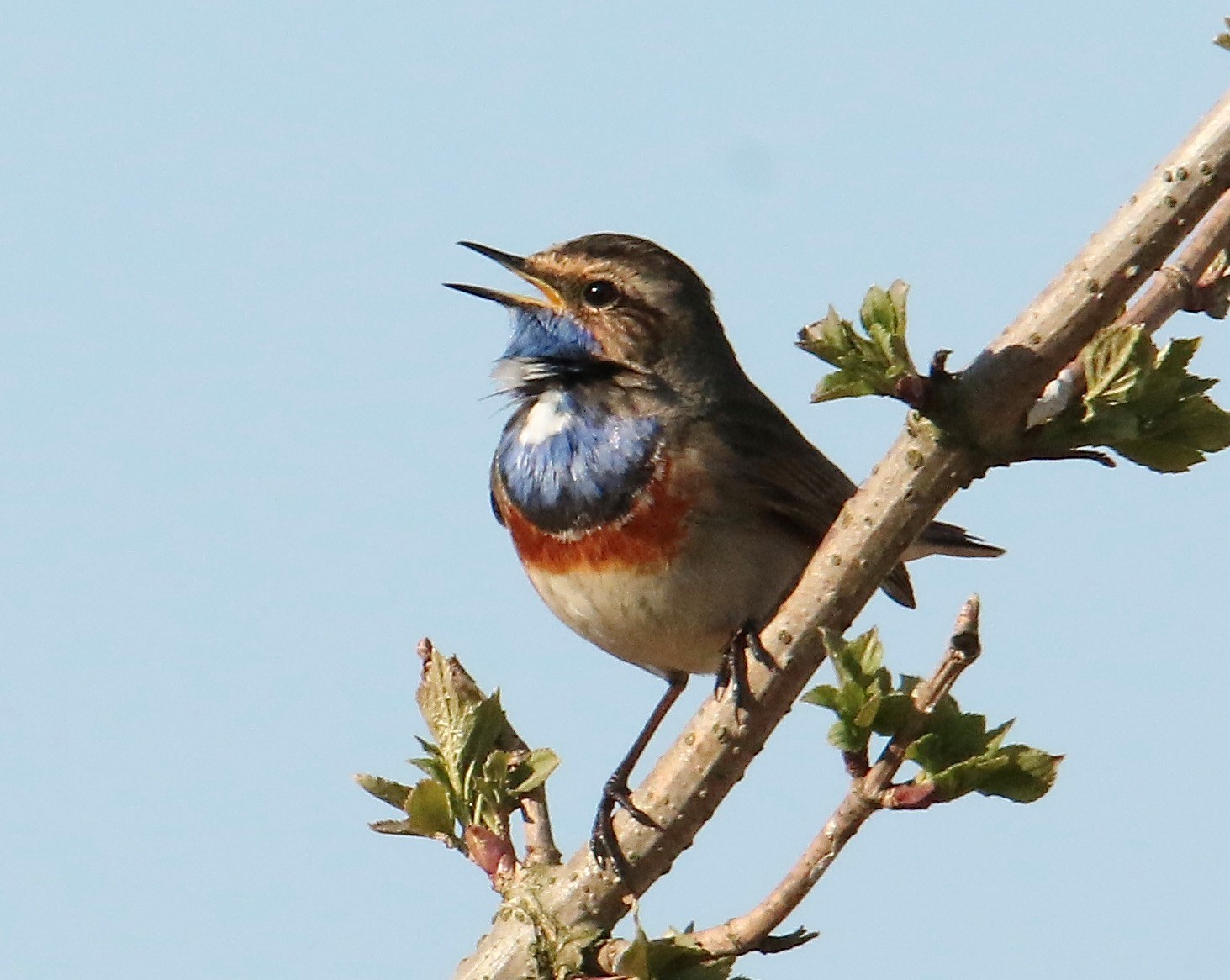
Bluethroat, Bispeenge. Photo: Bent Juhler
Brændegård Sø and Nørresø
Funen, around 10km north east of Fåborg
At Brændegård Sø there are good chances of seeing white-tailed eagle. Nørresø houses a cormorant colony and during the migration period both lakes are visited by large flocks of ducks.
See Google map with car parks etc.
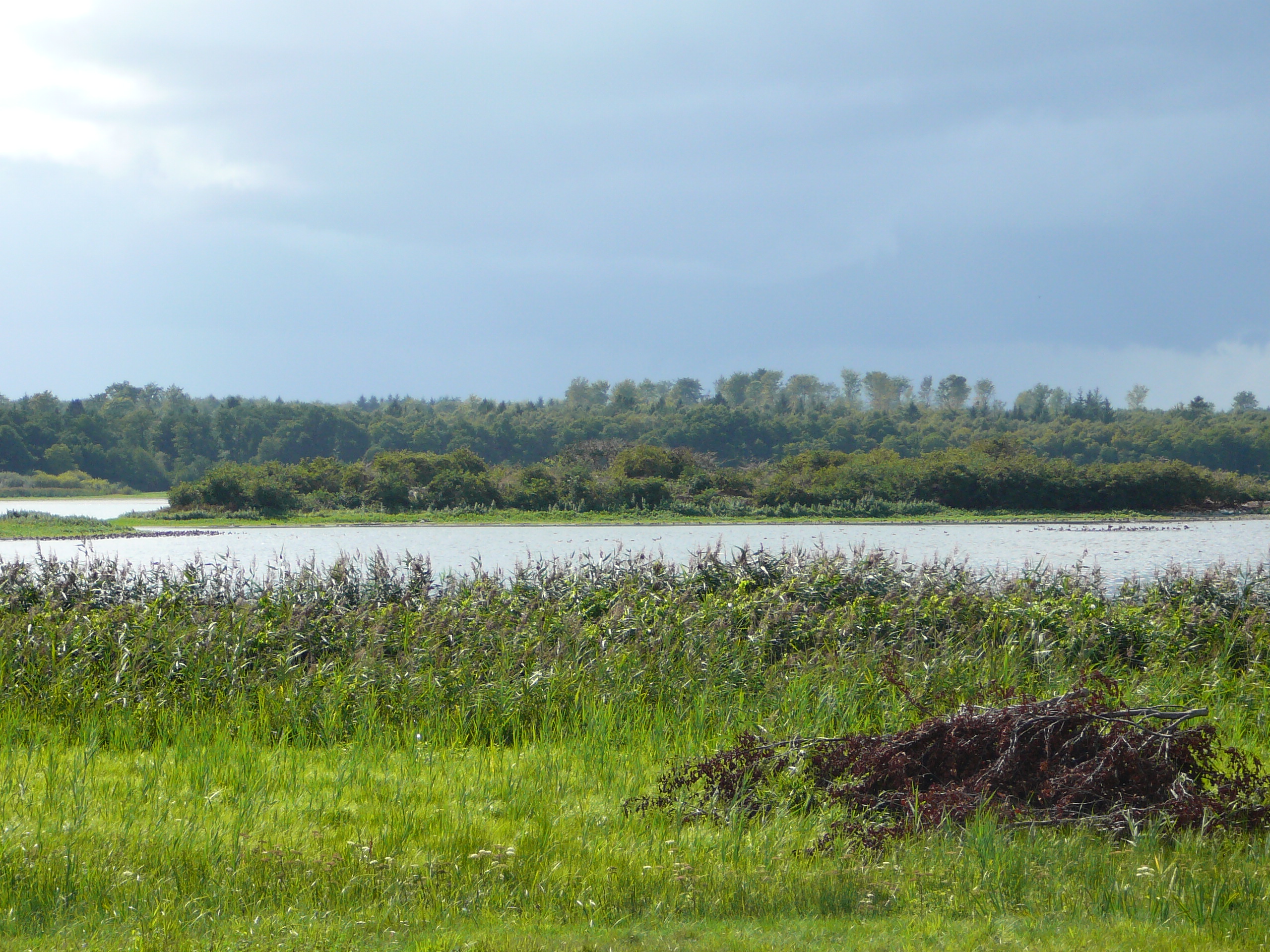
Brændegård Sø. Photo: Joy Klein
Description:
The lakes are situated in the attractive landscape known as De Fynske Alper (Funen’s Alps), and are among Funen’s best bird localities. Brændegård Sø is Funens third largest lake, covering 104ha. Both Brændegård Sø and Nørresø are situated in a beautiful and varied landscape, a large part of which is woodland. The woodland stretches out far in all directions, forming one of the largest forest areas on Funen.
Birds:
Altogether over 200 different bird species have been noted at Brændegård Sø, and nearly 120 at Nørresø.
Breeding birds:
Brændegård Sø is well known for its cormorant colony, which reached a peak in the 1990's with up to 7100 pairs and was one of the largest in Europe. Since then, numbers declined, and in 2019 there were no successful breeding pairs on the island in the lake, due to the presence of a large number of immature white-tailed eagles, who ate eggs and young and hunted the adult birds. In 2004, however, the cormorants started breeding at Nørresø, where they nest in trees along the edge of the lake and are in less danger from the eagles.
White-tailed eagle also breed near Brændegård Sø and can be seen all year round.
The island in Brændegård Sø is an unusual inland nesting site for three of the large gull species (herring gull, lesser black-backed gull and great black-backed gull). The lake also houses nesting great crested grebe, mute swan, greylag goose, shelduck, mallard and coot. Nørresø does not boast so many species of breeding bird, but there are small numbers of great crested grebe and mallard.
The surrounding woodlands are very varied and there are still large areas with old trees, which support several of the more unusual raptors such as white-tailed eagle, honey buzzard, red kite and goshawk. Other woodland species include woodcock, stock dove, tawny owl, raven and hawfinch.
Migrating and staging birds:
Large flocks of ducks and other waterfowl stage on Brændegård Sø outside the breeding season. Greylag goose, gadwall, mallard, shoveler, pochard, tufted duck and lapwing are seen in large numbers. Smew and goosander are seen in winter. Peregrine is a frequent visitor. In autumn, osprey is often spotted, and red kite and hen harrier are seen regularly. In Nørresø, flocks of mallard, pochard and tufted duck and now and again goosander can be seen. Great white egret is seen regularly in the area.
Visiting and access:
From route A8 between Nyborg and Fåborg, around 1km east of Brahetrolleborg, a road (Brændegårdsvej) leads south to Vester Åby. The road leads past the western end of Nørresø and continues past the eastern end of Brændegård Sø. There are also signs from route A44 between Svendborg and Fåborg in Vester Åby.
There is a car park at the entrance to Nørresø. A marked path (with yellow arrows) affords an almost constant view of the lake and good chances to enjoy the beautiful woodland. There are also places to rest on the way. Brændegård Sø can best be seen from the road to the east of the lake (in front of the Brændegård farm), where one can park on the roadside. From here there is a good view and one can study the information boards with details about the area.
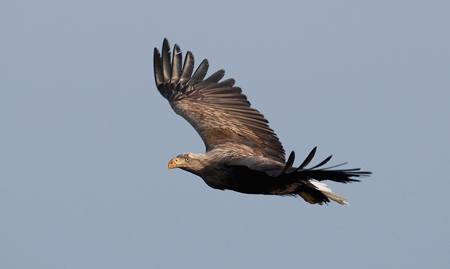
White-tailed eagle. Photo: Helge Sørensen
Bøjden Nor
South-west corner of Funen between Fåborg and Assens
Important staging site for swans, geese, ducks, waders and raptors. Denmark’s best locality for seeing scaup.
See Google map with car parks, observation hides, etc.
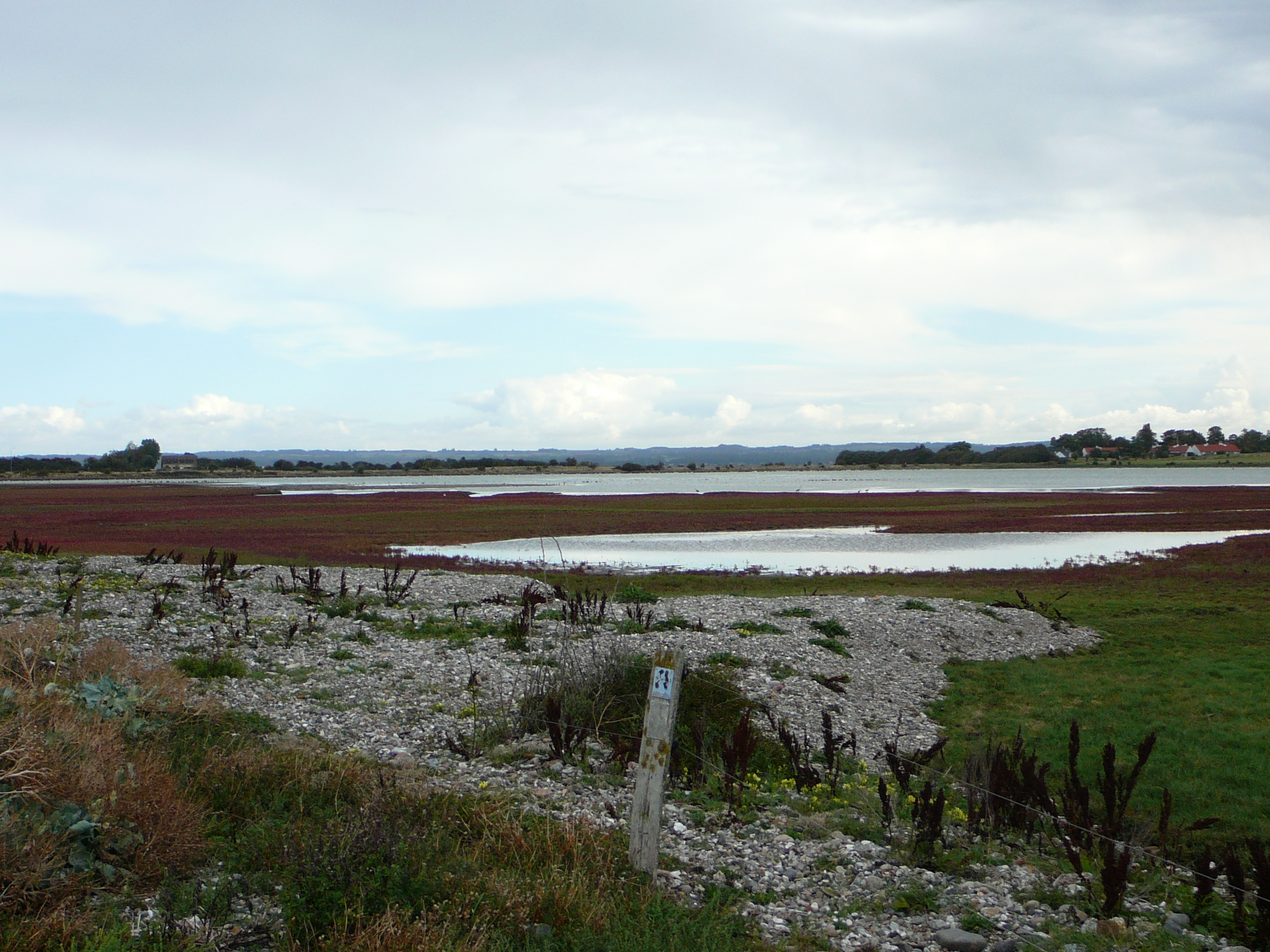
Bøjden Nor. Photo: Joy Klein
Description:
The lagoon of Bøjden Nor is situated on the west coast of the peninsula of Horneland, west of the town of Fåborg. Bøjden Nor was originally a small bay, but it gradually became cut off from the sea by a beach ridge. Today it is a shallow lagoon surrounded by grazed coastal meadows and bisected by a causeway leading to the Bøjden-Fynshav ferry port on the coast.
Bøjden Nor covers an area of 118ha, of which around 40ha are coastal meadow and have been a bird reserve since 1980. The reserve is owned by the Karen Krieger Foundation and administered by the Bird Protection Foundation. Between 2011 and 2013 a large EU LIFE+ nature re-establishment project was carried out. The Bird Protection Foundation has transformed 25ha of traditionally cultivated agricultural land to dry grassland, which is grazed by cattle, and at the same time has created small areas of wetland and pools for breeding amphibians. In addition, four artificial bird islands have been constructed in the lagoon. New paths have been laid down, giving a choice of different circular walks.
Birds:
Breeding birds:
Little grebe, mute swan, greylag goose, shelduck, mallard, tufted duck, coot, oystercatcher, avocet, little ringed plover, ringed plover, lapwing, redshank, black-headed gull, common gull, arctic tern and little tern breed in the reserve, together with many passerines, including larks.
Migrating and staging birds:
However, it is the large flocks of staging birds that make Bøjden Nor an important bird locality. Swans, geese, ducks, grebes, goosanders, coots, waders, gulls and terns forage and roost here. Raptors, including marsh harriers, are often seen flying over the area. Merlin has been spotted the last few years.
In April and May many waders stop off here before they continue their migration north. Many species of duck can be seen here in spring, summer and autumn.
In autumn, when the meadows are flooded, huge flocks of wigeon and teal congregate here. Waders appear again on their migration south - mostly in July/August, when they can be seen on the meadows, in the shallow water and along the coast.
Unless the lagoon freezes over, swans, geese, ducks and coots winter here in great numbers. Bøjden Nor is best known for the many thousands of tufted duck, pochard and scaup that can be seen from the bird hides in winter. The largest numbers of scaup are seen in February/March. There are only a few other sites in Denmark where such large congregations of scaup can be seen. Buzzard, rough-legged buzzard and kestrel visit the area regularly in winter and twite are often seen. Snow bunting turn up occasionally. White-tailed eagle hunts in the lagoon or over openings in the ice just north of the ferry port.
Visiting and access:
North of Fåborg, route 8 leads west towards Bøjden. On the outskirts of the village of Bøjden, on the left-hand side, signs along Dyndkrogvej show the way to two car parks, from where a nature trail leads to two bird hides. One of these is accessible for wheelchair users. (Note: This trail can unfortunately be inaccessible for wheelchairs in winter after rainfall). In the hides there are posters and leaflets offering information about the birds.
The lagoon can also be viewed from the beach or from the causeway out to the port. (There is a car park at the port). There is a car park north of Kalvørevej, from where there is access to a path in the northern part of the reserve. Kalvørevej is on the right-hand side when leaving Bøjden. There is also a car park at the port. In the waiting room there is an exhibition about birdlife at Bøjden Nor. Nearby is a new observation tower with a view across the reserve.
Visitors must keep to the paths in the reserve. There is no access to the enclosed meadows.
The Bird Protection Foundation has published a folder in English about Bøjden Nor, which can be downloaded here.

Scaup. Photo: Helge Sørensen
Enebærodde and Hofmansgave
Funen, northern part of Odense Fjord
Staging swans, geese, ducks and waders
See Google map with look-out points, car parks, etc.
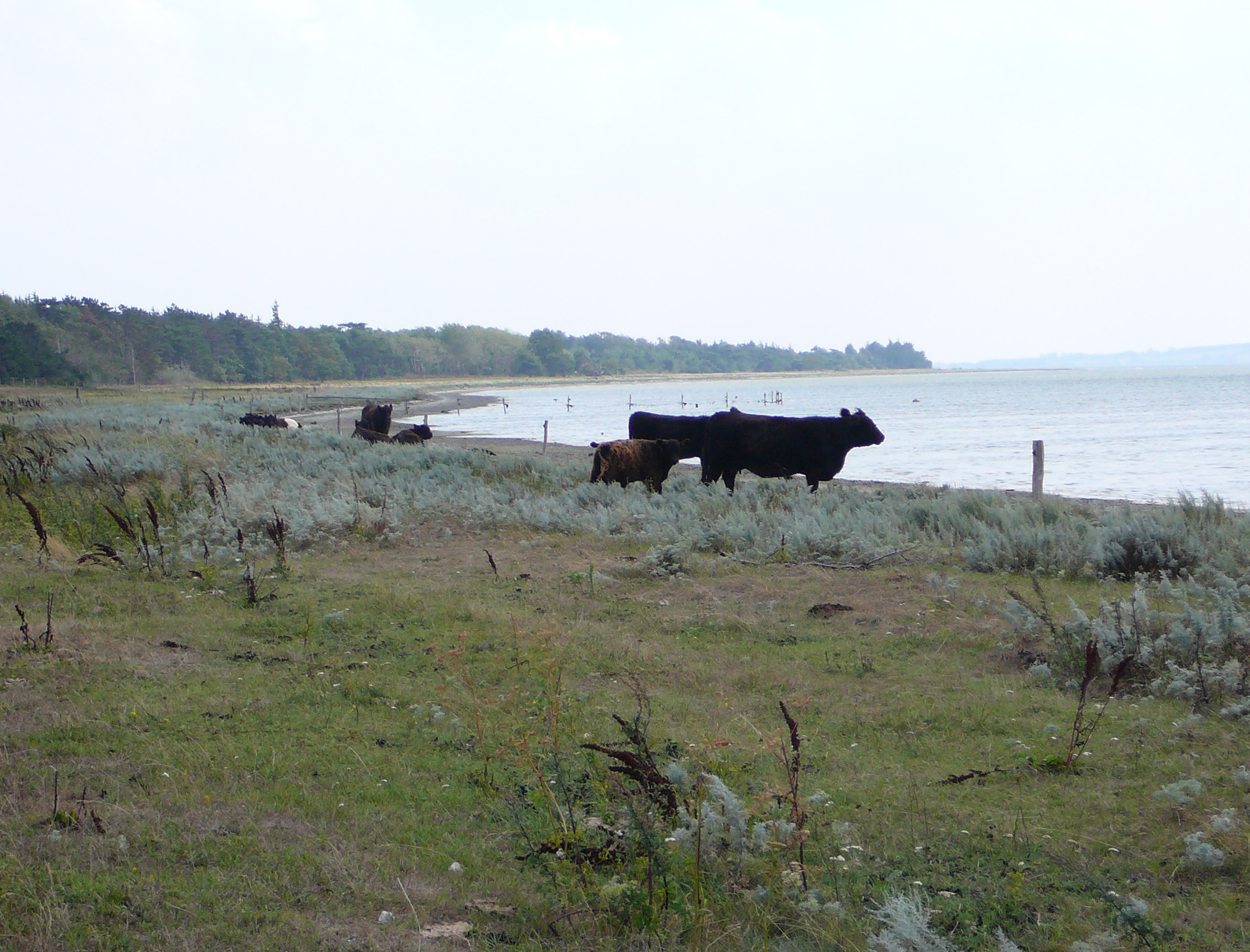
Enebærodde. Photo: Joy Klein
Description:
Enebærodde (‘Juniper Spit’) is a spit built up of pebbles, gravel and sand, and forms the western side of Odense Fjord. It is the largest heath on Funen and is under a preservation order. The heath is dominated by juniper, heather and crowberry. For the first few kilometres, the spit is fairly narrow with good views, both to the Kattegat side and over Odense Fjord. This stretch is a particularly good place for watching birds in the fjord. On the widest part of the spit is a little pine grove and some low bogs. At the tip of the spit is a lighthouse. Enebærodde is one of the most popular excursion areas on Funen.
Where Enebærodde joins the mainland, there are narrow, attractive coastal meadows that stretch all the way down to the estate of Hofmansgave. The house is surrounded by woodland and a beautiful park with good views across the fjord.
Birds:
Breeding birds:
Meadow pipit and skylark nest on the coastal meadows. Red-backed shrike can be spotted on the spit and most probably breeds here. In spring and summer, the park at Hofmansgave abounds with warblers and other passerines.
Migrating and staging birds:
In spring, flocks of passerines fly along the spit.
During spring and autumn migration, a good many waders can be seen, including oystercatcher, ringed plover, lapwing, dunlin, curlew and redshank. Bar-tailed godwit shows up occasionally. Ducks include especially wigeon, teal and mallard. Greylag geese, barnacle geese and whooper swans are attracted to the meadows between Hofmansgave and the pump station.
With luck, one can spot a peregrine or a white-tailed eagle.
During the winter months, many sea ducks, especially eider, common scoter and velvet scoter, can be seen together with red-breasted merganser on the sea outside the spit and in the narrow stretch of water between the spit and the Skoven peninsula on Hindsholm. The water here never freezes over. The park at Hofmansgave gives shelter to large flocks of wood pigeons. From February until the beginning of April many red-necked grebes forage in the sea north of Enebærodde before moving inland to their breeding sites or migrating further north.
Other animals:
In summer one can spot vipers at the very end of the spit. In spring, they lie under the rose bushes in the warm sand on the beach and in summer they prefer to lie in the heather.
Visiting and access:
To reach Enebærodde, take route 162 out of Odense to Otterup. In the town, follow the sign to Hasmark, and then the sign to Enebærodde, where there is a car park close to the gate leading onto Enebærodde. From here, one can either walk or cycle eastwards out to the end of the spit. The trip there and back is around 11km. One can also walk a few kilometres south from the car park to reach Hofmansgave.
To reach Hofmansgave by car, follow Strandvejen from Otterup to the village of Hasmark. At the crossroads, turn right, and at the church turn right again and drive along the avenue leading to Hofmansgave. One can park in the courtyard. From here, one can walk over to the embankment in the south-easternmost corner of the park to get a good view across Odense Fjord. One can also walk about 300m further north along a path through the fields and then turn right to reach a pump station. Here there are also good views, but take care not to disturb the birds – mostly ducks and waders – that sometimes are very close to.
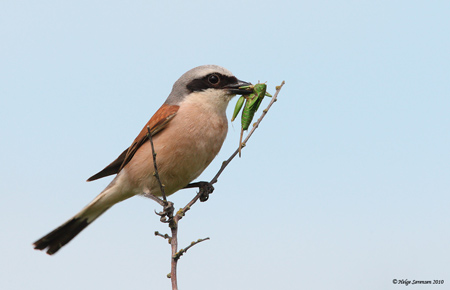
Red-backed shrike. Photo: Helge Sørensen
Fyns Hoved
Northernmost tip of Hindsholm peninsula, Funen, between Odense Fjord and Storebælt
Fyn’s most important watch-point for spring migration. Important stop-over site for waders and ducks.
See Google map with outlook points, car parks etc.

The northern part of the peninsula of Hindsholm consists of small islands, islets and crooked spits. There are a few copses and wet and dry meadows. Fyns Hoved itself has attractive scenery. The coast is stony with steep moraine cliffs, whilst inland the landscape is hilly with small ponds. The area is grazed by sheep and cattle and rows of stone walls mark the former field boundaries. The long spit called Tornen, which is a bird reserve, curves round the shallow lagoon of Fællesstrand. South of the lagoon is the Jøvet, an outlook point with a view southwards towards Lillestrand with the islands of Mejlø, Bogø and the Langehoved peninsula.
The Hindsholm peninsula was formed by a large glacier that pushed its way up through the Storebælt during the last ice age. It deposited moraine material in the form of drumlins that can be seen everywhere on the peninsula. The islands in Lillestrand are also drumlins that are now surrounded by water.
Birds:
Breeding birds:
Black guillemot nest in the cliffs at Lillestrand 3km to the south and can be seen out at sea off the coast of Fyns Hoved. Breeding birds at the reserves of Tornen and Lillestrand include mute swan, shelduck, eider, oystercatcher and ringed plover. Some years the rare little tern breeds here. Green woodpecker can be spotted all year round in the area with holiday cottages.
Migrating and staging birds:
Early in the morning at the end of April or May the thickets around Fyns Hoved can be swarming with passerines: every bush seems to have its robin, song thrush or willow warbler, and yellow wagtails are dotted around on the grass between the grazing cattle and sheep. The best chance of experiencing this is after misty nights with warm winds from the east.
The spring migration can best be seen from Horseklint on the eastern side of Fællesstrand or from Baesbanke, which is the highest point on Fyns Hoved itself (25m). Both land and sea migration can be watched from here. Many species of passerine fly past. Early in spring, the first skylarks appear, followed later on by finches, pigeons and crows. Later still, wagtails, pipits, hirundines, starlings and tits can be seen. The greater part of the raptors seen here are buzzards, which begin migrating in February together with a few red kites. In March/April, marsh harrier, kestrel, sparrowhawk and now and then an osprey can be spotted.
Over the sea, there are movements of large numbers of divers, cormorants and ducks, especially diving ducks, the commonest species being eider, common scoter and velvet scoter.
Fællesstrand is an important staging area for ducks and waders, that forage in the shallow waters. The commonest birds seen here are shelduck, mallard, wigeon, oystercatcher, redshank, dunlin, curlew, whimbrel, ringed plover and cormorant.The area also attracts many gulls, sandwich terns and arctic terns.
In the winter months, many seabirds can be seen on the sea around the peninsula. These include diving ducks such as goldeneye, auks, divers and skuas. Snow bunting, rock pipit and purple sandpiper can now and then be seen on the coast.
Other animals:
In May-June there is a good chance of hearing natterjack toads in the small ponds or flooded shallows on Fyns Hoved. In summer one can find vipers and lizards, if one moves quietly. With luck, a common seal or porpoise can be seen out at sea.
Visiting and access:
Fyns Hoved can be reached from route 315 which leads north from Kerteminde. The road continues to Korshavn, where one can park. From here, one can walk out to the tip of the peninsula or follow a path along the meadows on the south side of Fællesstrand. In this direction one comes to Horseklint, and can continue out to the Tornen spit. However, access to Tornen is forbidden during the breeding season from 1st April until 15th July. It is also possible to continue by car from Korshavn on a dirt track to a car park closer to the tip of the peninsula. From here, one must continue on foot.
There are toilets at the car park at Korshavn. From here, one can find a path leading up to the outlook point on Jøvet.
The Nature Agency has published a folder about Fyns Hoved with a useful map, which can be downloaded here.

Føns Vang
West coast of Funen, between Middelfart and Assens
A newly established wetland with many staging waterbirds. One of Funen’s finest bird localities for grebes and ducks.
See Google map with outlook points, car parks etc.

Føns Vang seen from the eastern end. Photo: Joy Klein
Føns Vang is a wetland covering 113ha that was re-established in 2005-2006 as part of a state project, in co-operation with the owner, Wedellsborg estate. Before it was drained, the area had formed part of Gamborg Fjord, but around 200 years ago it was drained and used for farming. To re-establish the wetland, the pump was stopped, the embankment next to the northern canal was broken through, and trees and bushes were removed. Around 110ha of the area is a fresh water lake, which is the second largest lake on Funen after Arreskov Sø. The lake is shallow, especially in the eastern end, and two islets have been established in the lake for breeding waterbirds. The lake has a natural outlet into Gamborg Fjord.
Immediately after it had been re-established, the lake was visited by large flocks of geese and ducks, and a rich birdlife was established. However, this has unfortunately declined in the meantime, as the water level has risen and there are no longer suitable areas for wading birds. Efforts to persuade the local authorities that the water level should be lowered have as yet not been succesful.
Breeding birds:
The lake houses a colony of around 15-20 cormorant. Both great crested grebe and little grebe nest here, together with a few pairs of red-necked grebe and black-necked grebe. Mute swan and tufted duck also breed. Kingfisher is seen regularly, especially near the observation tower.
Migrating and staging birds:
Mute swan, greylag goose, mallard, wigeon, teal, pochard, tufted duck, goldeneye and coot are seen all year round. Most of them increase in numbers in the autumn and winter months. Greylag geese often appear in large flocks with sometimes more than 1000 birds. Bean geese stage on the meadows. In summer, a few shelduck, gadwall, pintail and shoveler are seen. Great crested grebe are present throughout the year, whilst little grebe is most numerous in autumn.
White-tailed eagle, which nests nearby, is often spotted in the area. It can be seen either hunting over the lake for ducks, sitting in the surrounding trees, or sitting on the islet in the lake. In summer, marsh harrier forages in the area, and in winter hen harrier.
Both spring and summer, many sand martins and swallows can be watched as they fly to and fro across the lake, and in autumn the meadows attract flocks of starlings.
In winter, smew can be seen on the lake, and flocks of whooper swan on the fields.
Route 313 between Nørre Åby and Assens passes close to the eastern end of Føns Vang (about 5km south of Nørre Åby). Turning off the main road towards Føns brings one onto one of the minor roads that lead round the lake. There are several places where one can park and look out over the lake:

Gulstav Mose and the southern point of Langeland
South Langeland
Impressive autumn migration of raptors and passerines
See Google map with outlook points, car parks etc.

Gulstav Mose, Dovns Klint and Keldsnor. Photo: Bird Protection Foundation
The bog of Gulstav Mose is around 500m north of the cliff of Dovns Klint on the southermost point of Langeland. It is a nature reserve owned by the Danish Bird Protection Fund and covers around 7ha. It is a naturally nutrient-rich bog on limestone soil with small ponds, rushbeds and meadowland with orchids. At the beginning of the 1960s it was attempted to drain the bog and cultivate the land, but the project was unsuccessful. The area became overgrown, and when the Bird Protection Foundation acquired the area in 1971 there was only one pair of lapwing breeding in the area. In 1980, an embankment was built to hold back the water in the bog, and since then the number of plant and bird species has increased. The area can be seen from the bird observation tower at the northern edge of Gulstav Mose.
Gulstav Mose and the surrounding grassland is grazed by Exmoor ponies.
Just north-east of Dovns Klint is Keldsnor, which is an 80ha shallow lagoon with brackish water. It is cut off from the sea by a beach ridge formed by pebbles. A narrow strip of reeds borders the lagoon and there is meadowland at the edge of the beach ridge. In the south-west corner is woodland stretching right out to the water’s edge.
Breeding birds:
Over 40 species of breeding birds have been registered in Gulstav Mose. There are fairly large populations of little grebe, red-necked grebe, water rail and moorhen. In summer, reed warbler and marsh warbler sing in the bog. Some years, scarlet rosefinch can be heard. Lapwing nest on the meadow and red-backed shrike can be seen in the scatted hawthorn bushes.
Several bird species breed at Keldsnor, including great crested grebe and little grebe, mute swan, mallard, water rail, coot, oystercatcher, ringed plover, redshank and lapwing.
Migrating and staging birds:
Dovns Klint is, however, best known as a good locality for watching autumn migration. The best weather conditions are when there is a light wind from an easterly or southerly direction, good visibility and sunshine. Raptors, especially, can be seen in large numbers. Sparrowhawk and buzzard are the commonest species, but honey buzzard, marsh harrier, hen harrier, osprey, red kite, hobby, merlin and kestrel are also seen regularly. With luck, one may also spot peregrine or white-tailed eagle. Large flocks of crows and pigeons fly over the cliff, together with many passerines. Thrushes and finches sometimes fly past in enormous flocks. Many passerines settle in the scrub and the woodland before flying over the Baltic Sea to Germany. Eider, red-breasted merganser, barnacle goose, brent goose and wigeon can be seen flying west over the sea at the end of the breeding season.
In autumn, Keldsnor attracts many waders, including ringed plover, golden plover, lapwing, dunlin, spotted redshank and greenshank, and one can see raptors that stop over here before flying out over the sea. Many yellow wagtails forage on the meadows during autumn migration, and often roost for the night in Gulstav Mose.
Throughout the year, Keldsnor is a staging area for large numbers of different birds, dependent on the time of year. Cormorant, grey heron, greylag goose, coot and several species of duck – especially wigeon and tufted duck – can be seen most of the year. In winter, scaup, smew and goosander are also seen. Now and again less common birds appear, for example slavonian grebe, or even great white egret.
From Rudkøbing, follow route 305 south until 2km before Bagenkop, where the road bends sharply. Here there is a minor road going south to Dovns Klint. 500m before Dovns Klint, in a sharp bend, is a car park with access to Gulstav Mose. Here there is a fine view over the surrounding area from a bird observation tower on the northern edge of the reserve. The bog itself is not accessible to the public but there are no restrictions on the adjoining area which is owned by the Danish Nature Agency. This means that there is an increasing and considerable traffic here, especially along the western side of the bog.
At the end of the road is a large car park at Dovns Klint. The best place from which to observe migration is from the top of the cliff. If the migrating birds are concentrated a little further away to the west, one can stand on the top of the cliff of Gulstav Klint north-west of Dovns Klint.
There are toilets at the car park. 300m north of the car park, at Dovnsgården, is a nature centre with information about the area’s natural history and culture.
With luck, one can see passerines being ringed. This activity is carried out every year from the end of July to the end of October by a group of volunteers under the local section of the Ornithological Society. They also note down migration observations and count staging birds. Ringing is not done on a regular basis.

Gyldensteen Strand
North Funen
A large, newly restored natural area with both salt water fjord and fresh water lake – and many waterbirds
See Google-map with car parks, outlook posts, etc.

Gyldensteen Strand. Photo: Børge Pedersen
Description:
Gyldensteen Strand is situated on the north coast of Funen just east of Bogense and covers an area of 616ha. After the ice age, the area comprised a wide, shallow fjord, that covered 6km2 and was over 3m at its deepest point. To the north, the fjord was divided from the Kattegat by a chain of moraine islands: Langø, Lindholm, Store Stegø and Lille Stegø. In 1871, the fjord was enclosed by embankments and the old fjord bed was drained and used for pasture and hay-making. In the 1960s, power-driven pumps were installed and the area was cultivated. The low ground known as “Reservatet” was retained as a hunting reserve.
In 2011, Aage V. Jensen Naturfonden purchased the area in order to bring it back to its natural state. At the same time, data are to be collected for use in future projects in connection with climate-determined rises in sea level, and developments are being carefully followed by the University of Southern Denmark. The new Gyldensteen Strand was inaugurated in March 2014, when the sea dyke was broken through.
The dykes between Langø, Lindholm and Store Stegø have been removed, so that seawater has flooded into the area south of the island of Lindholm and has formed a shallow fjord 214ha in area called Kystlagunen (The Coastal Lagoon), in which there are also mudflats surrounded by narrow coastal meadows. 13 islets have been established to support the birdlife. The lagoon is bounded on the east by a north/south embankment on which runs a road (Langø). To the east of the embankment, a shallow, freshwater lake (Engsø) with 6 new islets and reedbeds has been established. The water level in the lake reached its full height in the winter of 2015/16. In the winter months, water level in the lake is higher than sea level, but in summer it is lower, due to condensation. “Reservatet” at Ore Strand is to continue as a mosaic of meadlowland, marsh and ponds. Just north of Eriksholm is a shallow lake with a rich birdlife, especially in spring when the water level is high. The lake dries out in summer.
Birds:
Gyldensteen Strand has become one of Funen’s best bird sites in just a very short time. The new wetlands attract many breeding geese, ducks, waders, gulls and terns. Large flocks of waterbirds are seen here all year round.
Breeding birds:
The coastal lagoon has proved to be a good breeding locality for gulls and terns, which benefit from the many artificial islets. Both black-headed gull, common gull, herring gull, great black-backed gull and arctic tern breed at the lagoon. The last few years, over 100 pairs of eider have bred on the islet of Lindholm in the coastal lagoon.
The freshwater lake supports little grebe, mute swan, greylag goose, shelduck, mallard, gadwall, pochard, tufted duck and coot. Black-necked grebe and red-necked grebe have also bred here. A fair number of avocet breed here, together with redshank and lapwing. There are colonies of black-headed gull, common gull and herring gull.
Migrating and staging birds:
At high tide, many greylag geese and lapwings stage in the lagoon. In autumn, flocks of golden plover appear. Large numbers of red-breasted merganser and goldeneye forage here.
Ever since the freshwater lake Engsø was established, it has attraced many staging waders, including some of the largest flocks of ruff seen on Funen. Wood sandpiper, spotted redshank, greenshank and dunlin are also seen in large numbers. The lake is a popular staging site for greylag geese, white-fronted geese and barnacle geese, and several dabbling ducks: mallard, gadwall, pintail, shoveler, teal and wigeon. Not to mention coot.
The shallow lake north of Eriksholm attracts many birds in the spring, for example ruff, ringed plovers, dunlin, and sometimes more than a hundred wood sandpipers, which is a record for Funen. At certain times, more than a hundred yellow wagtails have been seen at one time. In the winter months, several hundred geese and ducks are present in the area.
Raptors which are seen regularly include white-tailed eagle, peregrine and hen harrier. Osprey is a sporadic guest.
Rarities include great white egret, spoonbill, ruddy shelduck and white-winged black tern.
Other animals:
There is a large population of fallow deer at Gyldensteen Strand. They are usually concealed in the plantation of Langø Plantage.
Visiting and access:
Gyldensteen Strand can be reached from route 327 between Bogense and Vester Egense. From the road there is access to several car parks and look-out points. At Eriksholm there is a nature centre with exhibitions, disabled-friendly toilets and a schoolroom. Eriksholm can be reached by turning off route 327 northwards along the road called Langø, about halfway along the stretch of road that passes the area. At the southern end of the road are a car park and a car park for wheelchair users. The road continues along the embankment to Eriksholm and the nature centre. From here, paths and cycle trails lead to several outlook posts. To the west is a bird observation post at the old pump station, with a view over the lagoon. To the east, trails through the plantation lead to the newly renovated mill Langø Mølle, which is now an outlook tower with a lovely panorama over “Reservatet” and the sea.
There is a car park next to the road at the eastern end of the area, from where one can reach a new disabled-friendly bird observation tower “Egensehytten” in the south eastern corner of the Engsø. In the western end of the area are a car park and a disabled-friendly bird observation tower.
The Kystlagune is a nature reserve and there is no access to the public. Apart from the embankment, there is no access to the dykes around the Kystlagune.
A map of the area can be found in the Danish-language folder published by Aage V. Jensen Naturfonden.

Wood sandpiper. Photo: Klaus Dichmann
Monnet
Funen, southernmost tip of Tåsinge
Staging waterbirds
See Google map with outlook points, car parks etc.

Description:
Monnet is a unique, 126ha coastal meadow area on the southermost tip of the island of Tåsinge. Previously, Monnet was an area of shallow water between the coast of Tåsinge and Vårø Knude, which at that time was one of the many islets south of Funen. Gradually, clay and silt became deposited and vegetation took root. The coastal meadow is today completely flat and crossed by many tidal canals. Only the 8m high Vårø Knude rises up in the landscape.
The area is flooded by the sea in heavy storms and most of the meadow is therefore without bushes. Only the middle section is covered by scrub. From a botanical point of view, Monnet is one of the most important coastal meadows on Funen.
Unfortunately, conditions on Monnet have deteriorated during the last few years due to a lack of grazing and a serious predation problem, as a family of foxes have lived here for several years. The result has been a steep decline in the number of breeding oystercatcher, lapwing and redshank. Cattle have now been put out to graze again and this is a clear improvement. However, the number of foxes is still a big problem even though measures have been taken in an attempt to limit their numbers.
Breeding birds:
Several species of wader breed on Monnet, including oystercatcher, ringed plover, lapwing and redshank. Common gull and arctic tern nest on the small spits along the coast. Passerines such as skylark, meadow pipit and yellow wagtail nest on the meadow. Sand martins have nesting holes in Vårø Knude.
Migrating and staging birds:
Outside the breeding period, large flocks of staging ducks and waders can be seen on the meadow or on the shallow water. Mute swan, whooper swan, greylag goose, canada goose, barnacle goose and dark-bellied brent goose are regular guests. The most common ducks to be seen are shelduck, widgeon, teal, pintail, eider, goldeneye and red-breasted merganser.
Staging waders include curlew (which is seen throughout the year), golden plover, lapwing and dunlin. Smaller numbers of knot, curlew sandpiper, black-tailed godwite and bar-tailed godwit, spotted redshank, greenshank, wood sandpiper and common sandpiper are seen.
In winter, flocks of crows, fieldfares and twite, and a few rock pipits can be observed. Snow buntings are regular winter visitors.
The meadow is a good hunting ground for raptors. White-tailed eagle is seen daily - often sitting on Vårø Knude - as a pair have nested in a nearby wood the last few years. Kestrel and buzzard are seen all year round. The marsh harrier arrives in summer. In winter, hen harrier, rough-legged buzzard, peregrine and short-eared owl hunt in the area. A few merlin can be spotted during migration.
The meadow is characterized by anthills formed by the yellow meadow ant (Lasius flavus). The ants keep underground and cannot therefore be seen, except for one single day in August when they swarm (and attract large flocks of gulls).
Visiting and access:
From Svendborg, follow route 9 south towards Rudkøbing. Less than 2km south of Bregninge on the island of Tåsinge, drive towards Skovballe. From Skovballe, a minor road – Monnetvej – leads to a car park around 7km to the east. Here there is an information board.
From the car park, a farm track leads to a little yellow cattleman’s cottage by the gate opening onto the meadow. By going round the left side of the house, one can find a path leading to a bird hide. The hide, which is behind the stone wall at the eastern end of Monnet, is around 1.5m above sea level. From here there are good views across the flat landscape and the mudflats towards Langodde to the south and across the rest of Monnet to the west. From the hide, one can follow the coast out to Vårø Knude, which is at the southernmost point. From here there is a wonderful view over large parts of the south Funen archipelago.
It is permitted to walk everywhere along the coast and on the meadow, but there are restrictions during the period 15th March – 1st July due to breeding birds.
 Ringed plover. Photo: Albert Steen-Hansen
Ringed plover. Photo: Albert Steen-Hansen
Tryggelev Nor
South Langeland
Tryggelev Nor is the name of a bird reserve owned by the Bird Protection Foundation. Birds can be seen here all year round. Both geese, ducks, waders, raptors and passerines.
See Google map with outlook points, car parks etc.

Nørreballe Nor with Tryggelev Nor and Salme Nor in the background. Photo: Bird Protection Foundation
Description:
The reserve comprises Tryggelev Nor, Nørreballe Nor and Salme Nor. Nørreballe Nor was formerly drained for use as arable land, but was re-established as a lagoon in 2004. At the same time, four islets were established in the lagoon for the benefit of the birdlife. One of these has since disappeared. The whole reserve covers 180ha and Tryggelev/Salme Nor especially form a mosaic of open water, mudflats, reedbeds, meadows, open grassy areas and scrub. The meadows are grazed by cattle and horses, to ensure the best possible conditions for water birds.
The whole area is protected by the EF bird protection directive. The EU’s LIFE Nature fund has financed the improvements carried out here. The re-establishment of the Nørreballe Nor lagoon should result in the removal of around 70% of the nitrogen that has entered Tryggelev Nor in the course of time. There should also be an increased exchange of water between Tryggelev Nor and the bay of Marstal Bugt. In this way, some of the nutrients that have accumulated in the lagoon should disappear.
Birds:
Breeding birds:
Great crested grebe, red-necked grebe, little grebe, bittern, mute swan, greylag goose, garganey, shoveler, gadwall, marsh harrier, water rail and coot are among the breeding birds at Tryggelev Nor. Several waders breed in the area, including oystercatcher, avocet, ringed plover, lapwing and redshank. Greylag goose can be seen feeding on the meadows. Passerines such as thrush nightingale, reed warbler and bearded tit can be seen in the reedbeds and the scrub.
Migrating and staging birds:
Both spring and autumn, large flocks of waders, geese and ducks can be observed. Late summer and autumn sees the arrival of many waders that have started to migrate south through Denmark. They feed on the meadows and in the shallow water. There are thousands of ducks on the water in autumn, for example wigeon, gadwall, teal, garganey, pochard and tufted duck. Other staging water birds include grey heron, mute swan, greylag goose, barnacle goose, scaup and goosander.
In autumn, south Langeland often functions as a leading mark for raptors on their migration from Sweden southwards. On days with good weather, many sparrowhawks and buzzards can be seen, and with luck one may see an osprey catch a fish in the lagoon.
In winter, several thousand birds may stage on the lagoons, especially tufted ducks, scaup and coots.
Geese and whooper swans graze on the fields around the lagoons. Many diving ducks spend the winter in the bay off the reserve, especially eider, but also common scoter and long-tailed duck. Fieldfare and redwing find berries in the hawthorn bushes in winter, and bearded tit winter in the reedbeds, where they live off the seeds of the reeds.
The locality is one of the best sites on Langeland to see white-tailed eagle, which is a regular guest, especially in late summer, autumn and winter.
Visiting and access:
To Nørreballe Nor
At Humble, south of Rudkøbing, follow the signs to Ristinge. In Hesselbjerg, turn left along Nørreballevej. After 300m there is a car park with an information board and a view across Nørreballe Nor. Just next to the car park is a long barrow, which originates from the early neolithic period (around 3500 B.C.). After another 1km comes another car park on the right-hand side, from where a farm track leads down to Nørreballe Nor. From here, a trail leads along the lagoon, which it crosses on two bridges, and ends at an old pump station. From the dyke behind the station there is a view across the meadows north of Tryggelev Nor. There is no round trip, so one must take the same path back to the car park.
To Tryggelev/Salme Nor
One can also continue straight ahead in Hesselbjerg and so reach the coast and Tryggelev Nor and Salme Nor. Here there is a car park with information about the reserve and a trail along the beach leading to Salme Nor. One can also drive south round Tryggelev Nor to reach a car park on the reserve’s property. Here there is also an information board.
The whole area has a total of 5km of trails and three bird hides. Access is only permitted on roads and trails. Dogs must be kept on a lead. The Bird Protection Foundation’s leaflets about the reserve are available at the car parks.
N.B. At the time of writing (February 2024) access from the north is impossible due to winter flooding. It is not yet known when the damage will be repaired.

The trail at Nørreballe Nor. Photo: Helle Hjorth
Vejlen
Funen, the western part of Tåsinge
Staging waders, geese and ducks
See Google map with outlook points etc.
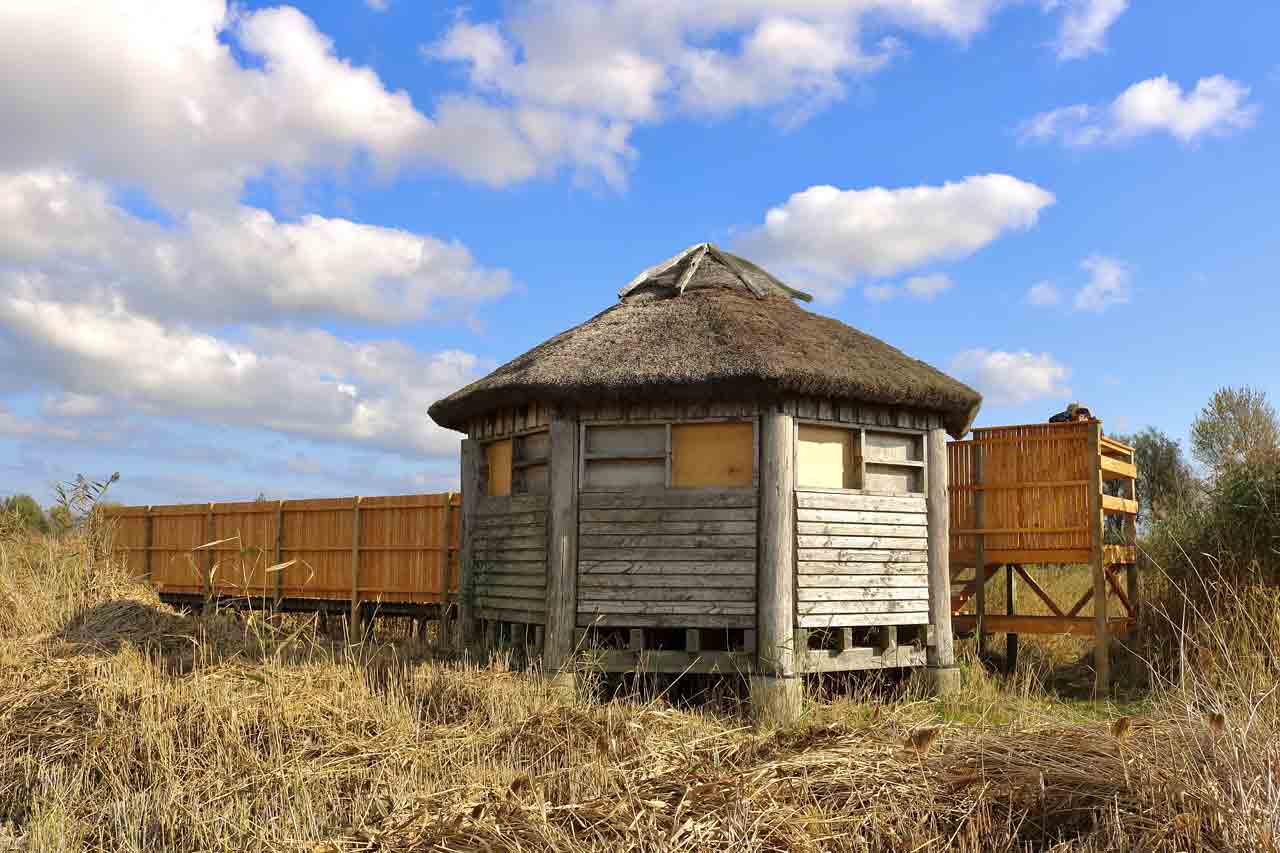
Vejlen - bird hide. Photo: Poul Rasmussen
Description:
Vejlen and Noret are owned by the Danish Nature Agency. Vejlen was previously a fjord connected to the sea, but in 1765 a dyke and sluice were built, cutting off the fjord. Vejlen was drained with a view to creating pastureland. On New Year's Eve 1904/05, the sea broke through the dyke. Even though it was reconstructed, Vejlen never became completely drained again. A very shallow lake (average depth: 0.6m) was formed, that is now brackish and very rich in nutrients, due to pollution from the surrounding farmland. In winter 2019-20 the Nature Agency erected a pump station on the embankment at the western end of Vejlen, due to the rising water level during the previous years. The high water level often caused problems in spring, when flooding destroyed many nests. It was also impossible to put cattle out to graze the areas with reedbeds to convert them to wet meadows. Experiments are still going on to determine when it would be best to start and stop the pump.
In the winter months the water level is not regulated because of the staging ducks and geese. About half the reedbeds have been cut down to help establish the wet meadows. The rest of the reedbeds have been preserved (especially at the eastern end near the hide) as a habitat for the reedbed birds.
There are plans to establish two to three islets in the lake in the hope of attracting breeding avocets.
Birds:
Breeding birds:
Different waterbirds breed in Vejlen, including little grebe, red-necked grebe, mute swan, greylag goose, mallard, coot, avocet, lapwing and redshank. A pair of marsh harriers breed here just about every year. Bearded tits nest here, and kingfisher can be seen throughout the year. In summer, reed warbler, icterine warbler, whitethroat and reed bunting can be heard singing in the scrub.
Migrating and staging birds:
In the migration period the lake and the shallow waters off the coast are staging localities for many species of wader. Golden plover can be seen both spring and autumn in flocks of up to several thousand birds standing on the fields in the vicinity. Other waders include lapwing and curlew in quite large numbers, and smaller numbers of oystercatcher, dunlin, ruff, snipe, spotted redshank, redshank and greenshank.
Mute swan can be seen throughout the year and in winter several hundred whooper swans and a few Bewick’s swans turn up. Staging greylag geese can be seen all year round, often in flocks of several hundred individuals. A few white-fronted geese can also be spotted.
White-tailed eagle can be seen foraging in the area. The last few years, up to six osprey have been seen foraging here on autumn migration, together with 4-5 caspian terns.
The lake also attracts many ducks, for example gadwall, teal, pintail, garganey and shoveler, although not in very large numbers. Tufted duck can be seen in larger flocks, sometimes more than 1000 birds. In winter, smew and goosander appear.
Visiting and access:
From Svendborg, drive south on route 9 in the direction of Rudkøbing. In Bregninge, turn off to the the right and follow the signs to Nørre Vornæs. In Sønder Vornæs, turn onto Sønder Vornæsvej and after a few hundred metres onto the Vejlenvej, where there is a lay-by. From here, a path leads to a bird hide. The hide has recently been renovated and an extra platform built.
Near Vejlen is a meadow area called Noret, where several ducks and waders breed, for example greylag goose, oystercatcher, ringed plover and lapwing. Bittern also breeds here. Noret is passed on the way to Vejlen, as described above. Coming from Bregninge, Noret is on the left-hand side after Nørre Vornæs. There is no access to Noret, but it can easily be viewed from the road.
By driving further west along Vornæsvej and then south along Søren Lolks Vej one reaches the dyke west of Vejlen, where one can park on a very small car park. From here there is a view both over Vejlen and over the shallow waters of the sea to the west.

Bewick's swan. Photo: Albert Steen-Hansen
Ølund-Lammesø nature reserve
Odense Fjord
One of Funen’s best bird sites, with breeding waders and staging geese and ducks.
See Google map
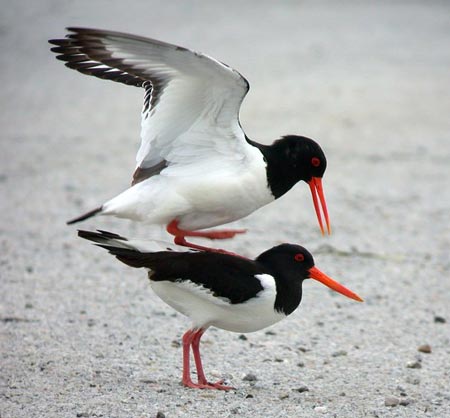
Oystercatchers. Photo: Albert Steen-Hansen
Description:
This area is situated on the west side of Odense Fjord around 4km east of Otterup. The area was originally part of Odense Fjord but was enclosed by a dyke in the 19th century to create agricultural land. In 1993, the fjord broke through the dykes at a period with high water levels and strong winds, and more than 100ha of land was flooded. A plan drawn up by DOF to restore the area to its original state persuaded the relevant authorities to consider re-establishing the wetland. A large part of the area was subsequently purchased by Aage V. Jensen Naturfond, which since then has purchased even more of the adjoining land, so that the nature reserve now covers 158ha. Around half of the 158ha are under water in winter and spring, but often dry out in the course of summer and autumn. Three islands have been established in the so-called “Mellemstykke”, that was re-established in 2009, and one island in the Lammesø enclosure.
Birds:
After it had been re-established, the area developed into an interesting bird site, with many breeding birds and thousands of staging migrants.
Breeding birds:
Lapwing, redshank and oystercatcher breed in the area. In addition, four species of grebe, mute swan, greylag goose and mallard breed each year, and shoveler and gadwall at regular intervals. The colonies of black-headed gull, which formerly comprised thousands of birds, have unfortunately now disappeared.
Migrating and staging birds:
During the migration season, large flocks of waders stop off here, including golden plover, lapwing, dunlin, bar-tailed godwit and curlew. Rarer species such as red-necked phalarope and broad-billed sandpiper are seen almost yearly. Geese, especially greylag geese and barnacle geese, stage in thousands, and there are smaller flocks of white-fronted geese. After the "Mellemstykke" area was re-established in 2009, the area has grown to be Funen's most important staging post for teal, together with the Engsø lake at Gyldensteen. In addition, the area attracts large flocks of wigeon, shoveler and gadwall.
In winter and spring, large flocks of whooper swans and geese arrive. Up to more than 2,000 greylag geese and 7,400 barnacle geese have been spotted, together with several hundred whooper swans. If there are flocks of whooper swans in the neighbourhood, they use the Ølund area to bathe and drink during the daytime.
White-tailed eagle can be spotted throughout the year, and peregrine is seen almost daily during the migration season.
Now and again rarities have shown up, for example white-tailed plover (2015), great reed warbler (2015, 2023), broad-billed sandpiper (2015, 2017, 2018, 2023) and red-necked phalarope (almost every year since 2015).
Visiting and access:
The nature reserve can be reached by driving north out of Odense on route 162 to Otterup, from where one drives east on Klintebjergvej. The road continues straight ahead (but its name changes to Skebyvej), leads through the village of Skeby and on to Hessum. In Hessum the road name changes to Hessum Bygade. At the T-junction at the eastern end of Hessum, one turns left, still on Hessum Bygade. After 200m one continues east along Ølundgyden. In Ølund, one turns left onto Lammesøvej and continues around 100m. The enclosed area at Ølundgård is directly south of Lammesøvej.
On Lammesøvej is a car-park with access to a bird observation tower which can be reached by following a dirt track around 500m in a northerly direction. From this tower there is an excellent view over the shore and the so-called “Mellemstykke”. One can also see part of Egensedybet, which is sometimes visited by white-tailed eagle.
From a little lay-by 100m east of the car-park, a large part of the reserve is visible. By staying in the car, it is possible to see the birds at close range. A few hundred metres further east is another car-park. From here, a path leads to another bird observation tower around 500m away, from where there is an excellent view over the enclosed area at Ølundgård.
It is a good idea to have a telescope when viewing the area from the towers.
 Barnacle geese. Photo: Klaus Malling Olsen
Barnacle geese. Photo: Klaus Malling Olsen



